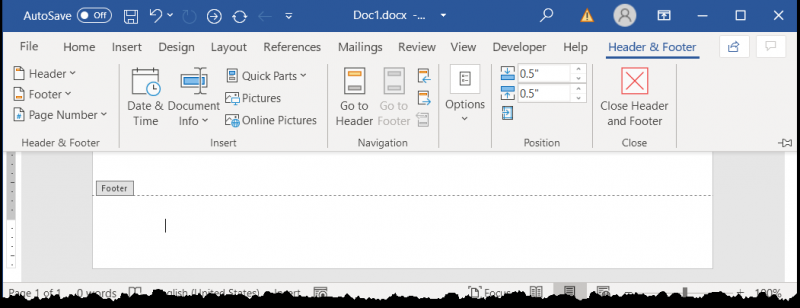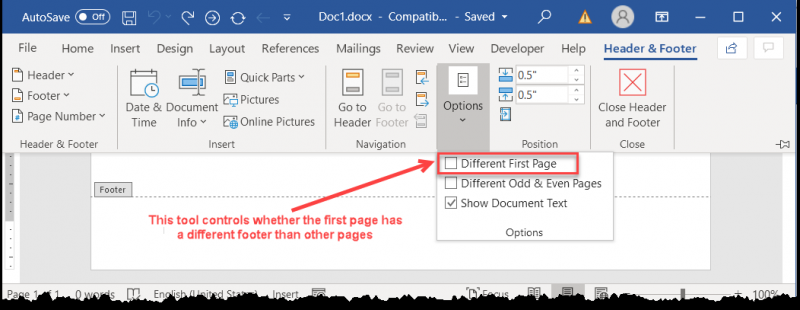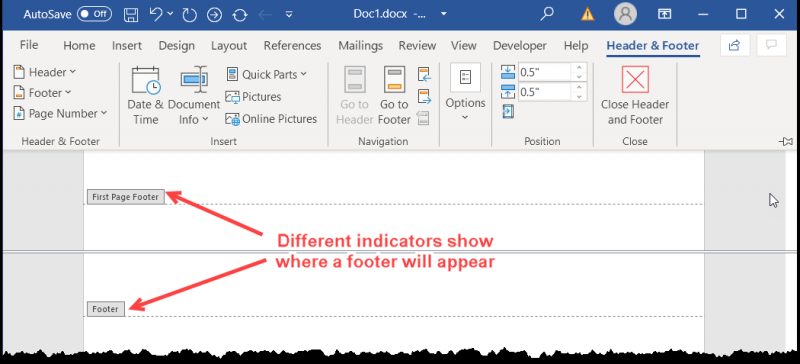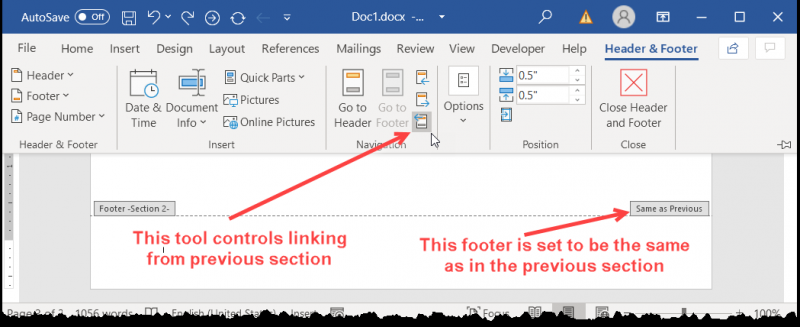Written by Allen Wyatt (last updated November 27, 2021)
This tip applies to Word 2007, 2010, 2013, 2016, 2019, and 2021
Lu is a lawyer in Australia who has now had to change to Word for work purposes. He would like to be able to put two footers on each page of his document. He is required by law to have a "liability warning" appear on all correspondence, so he has placed that warning in a footer. However, in multipage documents Lu would like a note to also appear at the bottom of each page indicating that a further page is following such as ".../2" at the bottom of page 1 to indicate that there is a page 2 to follow. He wonders how he can have a second footer to include this indicator.
The headers and footers you can include in Word are quite flexible, although that flexibility may not be apparent to someone just starting out with the program as Lu is. While Word doesn't technically allow the definition of multiple footers for any given page, there are actually several different ways that Lu's scenario can be approached, depending on his exact needs. Those needs are defined, in this case, by the number of pages in a document.
First, if the document is a single page, then you only need the liability warning to appear at the bottom of the page. That is easy; just stuff the warning into the footer and you are good to go.
If the document is multiple pages, however, then you might want the liability warning to appear only one time, such as on the first page of the document and not on subsequent pages. That is easy, too—just configure Word for a different footer on the first page of the document. Follow these steps:

Figure 1. The Header & Footer tab of the ribbon.

Figure 2. Controlling different footers for a document.

Figure 3. Word indicates where a footer will appear.
That's it; your liability warning will appear on the first page and all subsequent pages will contain just the continuation text.
If you want to switch the scenario so that all the pages contain the continuation text but only the last page contains the liability warning, then things get a bit trickier. The reason is because Word doesn't include a "last-page footer" like it does a first-page footer. Instead, you'll need to resort to the use of fields in your footer to indicate what you want on the last page vs. what is on the other pages. How you do this has been covered in other WordTips.
The steps already described mention putting your liability warning in one footer paragraph and your continuation text in a different footer paragraph. (See steps 8 through 11.) Some people prefer to get a bit fancier with what they enter in the footers and use a table there. This is easy enough to do; Word has no problem with inserting a table in a footer. You could then use different rows, columns, and cells in the table to contain your liability warning, your continuation text, and anything else you want placed there.
Another approach entirely is to remember that headers and footers are an attribute of sections, meaning that each section in your document can have a different set of headers and footers than other sections. So, you could place a section break (of any type) within your document and then define a different footer for the pages before the section break and a different footer for the pages after the section break. The trick is to remember that you need to "unlink" the footer in the second section from the footer in the first section. You do that by following these steps:

Figure 4. Modifying linkage of footer information.
Of course, things get trickier as you add more and more sections to your document. That is because, again, headers and footers are an attribute of sections, and each section can have a different set of headers and footers. So, if your document has four sections (each delineated by a section break), then you can have 12 different headers (four first-page headers, four odd-page headers, and four even-page headers) and 12 different footers (again, four first-page, four odd-page, and four even-page). It can take some thought to figure out what you want to appear in these headers in your final document.
WordTips is your source for cost-effective Microsoft Word training. (Microsoft Word is the most popular word processing software in the world.) This tip (13249) applies to Microsoft Word 2007, 2010, 2013, 2016, 2019, and 2021.

The First and Last Word on Word! Bestselling For Dummies author Dan Gookin puts his usual fun and friendly candor back to work to show you how to navigate Word 2019. Spend more time working and less time trying to figure it all out! Check out Word 2019 For Dummies today!
Headers and footers can be used for all sorts of information to help orient your document reader. In fact, Word provides ...
Discover MoreHeaders and footers add a finishing touch to documents, but sometimes they can be bothersome. You may need to remove them ...
Discover MoreHeaders and footers add a nice finishing touch to a document you plan on printing. You may want all sorts of information ...
Discover MoreFREE SERVICE: Get tips like this every week in WordTips, a free productivity newsletter. Enter your address and click "Subscribe."
There are currently no comments for this tip. (Be the first to leave your comment—just use the simple form above!)
Got a version of Word that uses the ribbon interface (Word 2007 or later)? This site is for you! If you use an earlier version of Word, visit our WordTips site focusing on the menu interface.
Visit the WordTips channel on YouTube
FREE SERVICE: Get tips like this every week in WordTips, a free productivity newsletter. Enter your address and click "Subscribe."
Copyright © 2026 Sharon Parq Associates, Inc.
Comments